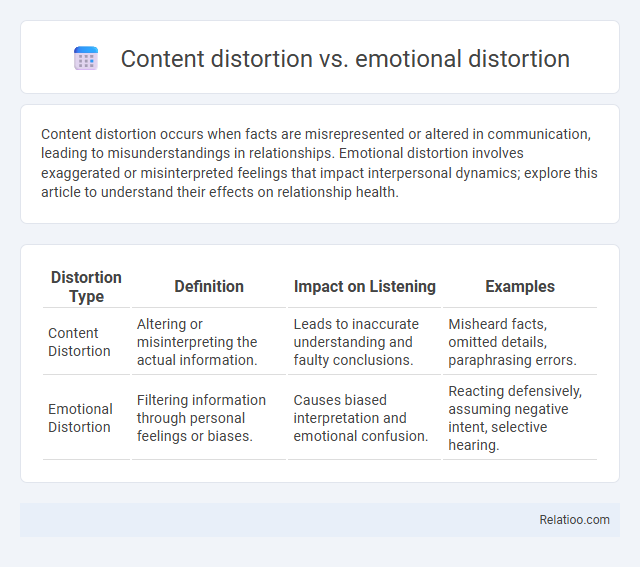Content distortion occurs when facts are misrepresented or altered in communication, leading to misunderstandings in relationships. Emotional distortion involves exaggerated or misinterpreted feelings that impact interpersonal dynamics; explore this article to understand their effects on relationship health.
Table of Comparison
| Distortion Type | Definition | Impact on Listening | Examples |
|---|---|---|---|
| Content Distortion | Altering or misinterpreting the actual information. | Leads to inaccurate understanding and faulty conclusions. | Misheard facts, omitted details, paraphrasing errors. |
| Emotional Distortion | Filtering information through personal feelings or biases. | Causes biased interpretation and emotional confusion. | Reacting defensively, assuming negative intent, selective hearing. |
Understanding Content Distortion
Content Distortion occurs when the original message is altered, leading to misinterpretation or loss of key information, whereas Emotional Distortion involves skewing perceptions based on feelings rather than facts. Distortion encompasses any alteration that affects clarity or truth, but understanding Content Distortion specifically helps you maintain accuracy and integrity in communication. Mastering this distinction is crucial for effectively conveying your intended meaning without unintended bias or confusion.
Defining Emotional Distortion
Emotional distortion refers to the alteration of emotional experiences or perceptions, often leading to exaggerated or diminished feelings that can affect decision-making and behavior. Unlike content distortion, which involves the misrepresentation of factual information, emotional distortion impacts the subjective interpretation of events rather than objective details. Your awareness of emotional distortion can improve emotional intelligence and help maintain balanced reactions in various situations.
Key Differences Between Content and Emotional Distortion
Content distortion refers to the alteration or misrepresentation of factual information, while emotional distortion involves the manipulation or exaggeration of feelings and emotional responses. Your understanding of these key differences is crucial for effective communication, as content distortion affects the accuracy of data, whereas emotional distortion influences perception and emotional impact. Distortion in general can encompass both types but distinguishing between them helps in identifying whether the issue lies in facts or in the emotional framing of a message.
Causes of Content Distortion
Content distortion arises primarily from misinterpretation, incomplete information, or intentional manipulation during communication. Emotional distortion occurs when personal biases or feelings alter the perception of information, skewing its original meaning. General distortion may result from cognitive biases, external influences, or technological errors that disrupt accurate message transmission.
Triggers Behind Emotional Distortion
Emotional distortion occurs when personal biases and unresolved psychological triggers reshape the perception of reality, often amplifying negative feelings like fear or anger. Content distortion involves altering factual information, while general distortion broadly refers to any deviation from truth or accuracy. The primary triggers behind emotional distortion include past trauma, stress, and cognitive dissonance, which can skew emotional responses and inhibit clear judgment.
Signs and Symptoms of Content Distortion
Content distortion is characterized by altered or misleading information that changes the original message, often signaled by inconsistencies in facts, exaggerated claims, and selective omission of key details. Emotional distortion manifests through amplified feelings such as excessive fear, anger, or sadness that skew perception, typically revealed by heightened emotional responses disproportionate to the context. General distortion involves cognitive biases, memory errors, or misinterpretations that blur reality, with signs including contradictory statements, confusion, and difficulty recalling accurate details.
Impact of Emotional Distortion on Perception
Emotional distortion alters an individual's perception by intensifying or diminishing feelings linked to a message, often leading to biased interpretations or misjudgments that differ from the original intent. Unlike content distortion, which modifies factual information, emotional distortion manipulates the affective response, thereby shaping attitudes, memories, and decision-making processes. This divergence significantly impacts communication effectiveness, as emotional distortion can trigger cognitive biases and reduce objective understanding.
Real-World Examples of Each Distortion
Content distortion manipulates facts or context in news articles, like misleading headlines exaggerating study results to sway public opinion. Emotional distortion occurs in advertising, where fear or happiness is amplified to influence your buying decisions, such as commercials showing overly dramatic consequences for not using a product. General distortion can be seen in social media, where altered images or selective reporting misrepresent reality, causing widespread misinformation and mistrust.
Overcoming Content and Emotional Distortion
Overcoming content and emotional distortion requires recognizing how inaccurate or biased information (content distortion) and altered feelings or perceptions (emotional distortion) affect decision-making and communication. Techniques such as critical thinking, emotional regulation, and cognitive restructuring help individuals identify false narratives and manage emotional biases effectively. By developing awareness and applying evidence-based interventions, people can minimize the impact of both content and emotional distortions, leading to clearer understanding and healthier responses.
Enhancing Awareness to Reduce Distortion
Content distortion involves the alteration or misrepresentation of factual information, while emotional distortion refers to the skewing of perceptions influenced by strong feelings or biases. Understanding these distinctions enhances awareness, enabling individuals to critically evaluate messages and reduce misinterpretations. Applying cognitive techniques and media literacy can significantly mitigate both content and emotional distortions, fostering clearer communication and informed decision-making.

Infographic: Content Distortion vs Emotional Distortion
 relatioo.com
relatioo.com